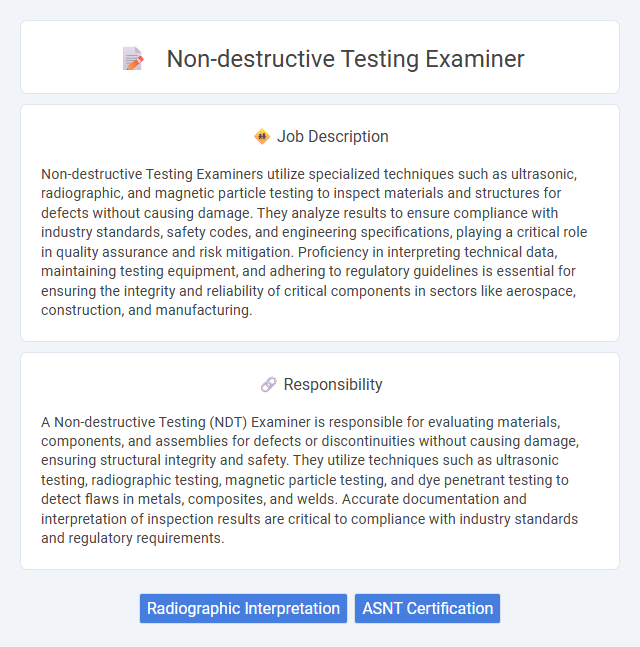
Non-destructive Testing Examiners utilize specialized techniques such as ultrasonic, radiographic, and magnetic particle testing to inspect materials and structures for defects without causing damage. They analyze results to ensure compliance with industry standards, safety codes, and engineering specifications, playing a critical role in quality assurance and risk mitigation. Proficiency in interpreting technical data, maintaining testing equipment, and adhering to regulatory guidelines is essential for ensuring the integrity and reliability of critical components in sectors like aerospace, construction, and manufacturing.
Individuals with strong attention to detail and good problem-solving skills are likely to be suitable for a Non-destructive Testing Examiner role. Those who can maintain focus under pressure and possess steady hand-eye coordination may find this job aligns well with their capabilities. Physical endurance and the ability to work in various environments could increase the probability of success in this position.
Qualification
A Non-destructive Testing (NDT) Examiner must possess certification in recognized NDT methods such as Ultrasonic Testing (UT), Radiographic Testing (RT), Magnetic Particle Testing (MT), or Dye Penetrant Testing (PT), adhering to industry standards like ASNT or ISO 9712. Proficiency in interpreting NDT results, comprehensive understanding of testing procedures, and strong analytical skills are essential qualifications. Experience working with inspection equipment and familiarity with safety regulations in non-destructive testing environments significantly enhance candidate suitability.
Responsibility
A Non-destructive Testing (NDT) Examiner is responsible for evaluating materials, components, and assemblies for defects or discontinuities without causing damage, ensuring structural integrity and safety. They utilize techniques such as ultrasonic testing, radiographic testing, magnetic particle testing, and dye penetrant testing to detect flaws in metals, composites, and welds. Accurate documentation and interpretation of inspection results are critical to compliance with industry standards and regulatory requirements.
Benefit
A Non-destructive Testing Examiner likely enjoys significant job stability due to the essential role in ensuring safety and quality across industries like aerospace, construction, and manufacturing. The position probably offers competitive salaries and opportunities for career advancement as expertise in various NDT methods grows. Employees may also benefit from a safer work environment by identifying potential failures before they lead to accidents or costly downtime.
Challenge
Non-destructive Testing Examiner roles likely present significant challenges in accurately detecting material flaws without causing damage, requiring high precision and expertise. The probability of encountering complex defects in various industrial environments demands continuous skill development and adaptation to advanced testing technologies. This position often involves interpreting subtle data signals, making critical decisions under uncertainty to ensure safety and compliance.
Career Advancement
Non-destructive Testing Examiners possess critical skills in evaluating materials and structures without causing damage, opening pathways to advanced certifications such as Level II and Level III in various NDT methods. Career advancement often leads to specialized roles in quality assurance, safety inspection management, or technical consultancy within industries like aerospace, oil and gas, and manufacturing. Continuous professional development in ultrasonic, radiographic, magnetic particle, and penetrant testing significantly enhances job prospects and leadership opportunities.
Key Terms
Radiographic Interpretation
Non-destructive Testing (NDT) Examiners specializing in Radiographic Interpretation analyze X-ray and gamma-ray images to detect internal defects in materials without causing damage. Expertise in interpreting radiographic film and digital radiography ensures the identification of weld flaws, cracks, porosity, and inclusions in critical components across industries such as aerospace, oil and gas, and construction. Proficiency with industry standards like ASNT SNT-TC-1A and API 1104 is essential for maintaining safety and quality compliance.
ASNT Certification
An ASNT Certification is essential for a Non-Destructive Testing Examiner, validating expertise in techniques such as ultrasonic, radiographic, magnetic particle, and dye penetrant testing. Employers prioritize certified examiners to ensure compliance with industry standards like SNT-TC-1A and EN ISO 9712, enhancing inspection reliability and safety. Holding an ASNT Level II or III certification significantly improves career prospects by demonstrating proficiency in test procedures, equipment calibration, and flaw detection.
 kuljobs.com
kuljobs.com